Ingmar Weber
VME: A Satellite Imagery Dataset and Benchmark for Detecting Vehicles in the Middle East and Beyond
May 28, 2025Abstract:Detecting vehicles in satellite images is crucial for traffic management, urban planning, and disaster response. However, current models struggle with real-world diversity, particularly across different regions. This challenge is amplified by geographic bias in existing datasets, which often focus on specific areas and overlook regions like the Middle East. To address this gap, we present the Vehicles in the Middle East (VME) dataset, designed explicitly for vehicle detection in high-resolution satellite images from Middle Eastern countries. Sourced from Maxar, the VME dataset spans 54 cities across 12 countries, comprising over 4,000 image tiles and more than 100,000 vehicles, annotated using both manual and semi-automated methods. Additionally, we introduce the largest benchmark dataset for Car Detection in Satellite Imagery (CDSI), combining images from multiple sources to enhance global car detection. Our experiments demonstrate that models trained on existing datasets perform poorly on Middle Eastern images, while the VME dataset significantly improves detection accuracy in this region. Moreover, state-of-the-art models trained on CDSI achieve substantial improvements in global car detection.
Misleading through Inconsistency: A Benchmark for Political Inconsistencies Detection
May 25, 2025Abstract:Inconsistent political statements represent a form of misinformation. They erode public trust and pose challenges to accountability, when left unnoticed. Detecting inconsistencies automatically could support journalists in asking clarification questions, thereby helping to keep politicians accountable. We propose the Inconsistency detection task and develop a scale of inconsistency types to prompt NLP-research in this direction. To provide a resource for detecting inconsistencies in a political domain, we present a dataset of 698 human-annotated pairs of political statements with explanations of the annotators' reasoning for 237 samples. The statements mainly come from voting assistant platforms such as Wahl-O-Mat in Germany and Smartvote in Switzerland, reflecting real-world political issues. We benchmark Large Language Models (LLMs) on our dataset and show that in general, they are as good as humans at detecting inconsistencies, and might be even better than individual humans at predicting the crowd-annotated ground-truth. However, when it comes to identifying fine-grained inconsistency types, none of the model have reached the upper bound of performance (due to natural labeling variation), thus leaving room for improvement. We make our dataset and code publicly available.
A Weak Supervision Learning Approach Towards an Equitable Parking Lot Occupancy Estimation
May 07, 2025



Abstract:The scarcity and high cost of labeled high-resolution imagery have long challenged remote sensing applications, particularly in low-income regions where high-resolution data are scarce. In this study, we propose a weak supervision framework that estimates parking lot occupancy using 3m resolution satellite imagery. By leveraging coarse temporal labels -- based on the assumption that parking lots of major supermarkets and hardware stores in Germany are typically full on Saturdays and empty on Sundays -- we train a pairwise comparison model that achieves an AUC of 0.92 on large parking lots. The proposed approach minimizes the reliance on expensive high-resolution images and holds promise for scalable urban mobility analysis. Moreover, the method can be adapted to assess transit patterns and resource allocation in vulnerable communities, providing a data-driven basis to improve the well-being of those most in need.
Coverage Biases in High-Resolution Satellite Imagery
May 05, 2025Abstract:Satellite imagery is increasingly used to complement traditional data collection approaches such as surveys and censuses across scientific disciplines. However, we ask: Do all places on earth benefit equally from this new wealth of information? In this study, we investigate coverage bias of major satellite constellations that provide optical satellite imagery with a ground sampling distance below 10 meters, evaluating both the future on-demand tasking opportunities as well as the availability of historic images across the globe. Specifically, forward-looking, we estimate how often different places are revisited during a window of 30 days based on the satellites' orbital paths, thus investigating potential coverage biases caused by physical factors. We find that locations farther away from the equator are generally revisited more frequently by the constellations under study. Backward-looking, we show that historic satellite image availability -- based on metadata collected from major satellite imagery providers -- is influenced by socio-economic factors on the ground: less developed, less populated places have less satellite images available. Furthermore, in three small case studies on recent conflict regions in this world, namely Gaza, Sudan and Ukraine, we show that also geopolitical events play an important role in satellite image availability, hinting at underlying business model decisions. These insights lay bare that the digital dividend yielded by satellite imagery is not equally distributed across our planet.
Ten Years after ImageNet: A 360° Perspective on AI
Oct 01, 2022
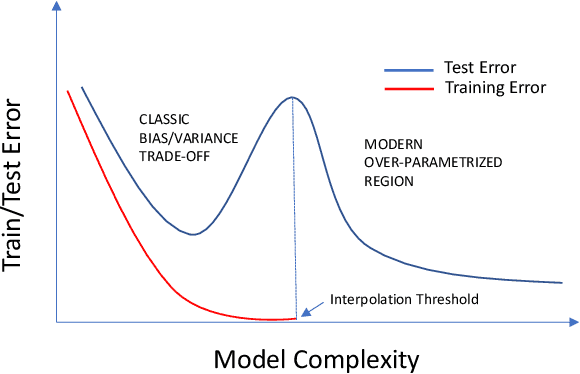

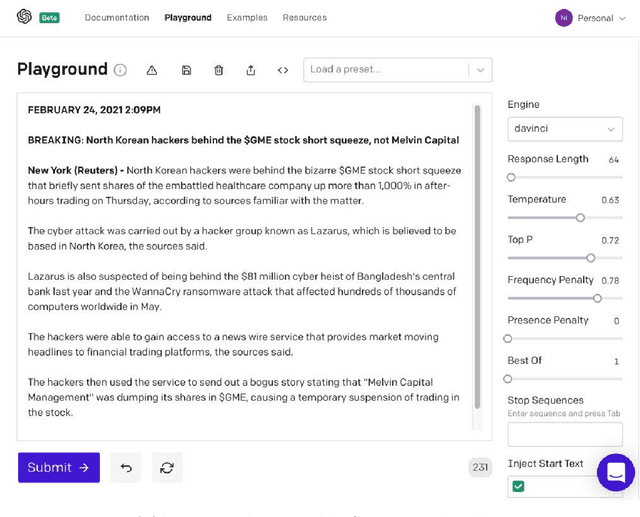
Abstract:It is ten years since neural networks made their spectacular comeback. Prompted by this anniversary, we take a holistic perspective on Artificial Intelligence (AI). Supervised Learning for cognitive tasks is effectively solved - provided we have enough high-quality labeled data. However, deep neural network models are not easily interpretable, and thus the debate between blackbox and whitebox modeling has come to the fore. The rise of attention networks, self-supervised learning, generative modeling, and graph neural networks has widened the application space of AI. Deep Learning has also propelled the return of reinforcement learning as a core building block of autonomous decision making systems. The possible harms made possible by new AI technologies have raised socio-technical issues such as transparency, fairness, and accountability. The dominance of AI by Big-Tech who control talent, computing resources, and most importantly, data may lead to an extreme AI divide. Failure to meet high expectations in high profile, and much heralded flagship projects like self-driving vehicles could trigger another AI winter.
Going beyond accuracy: estimating homophily in social networks using predictions
Jan 30, 2020
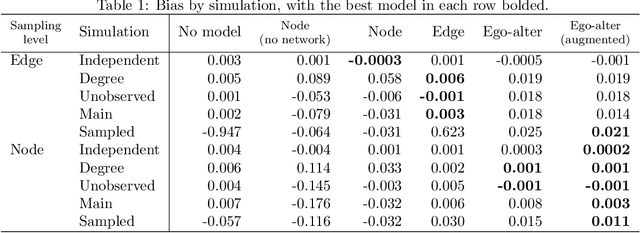

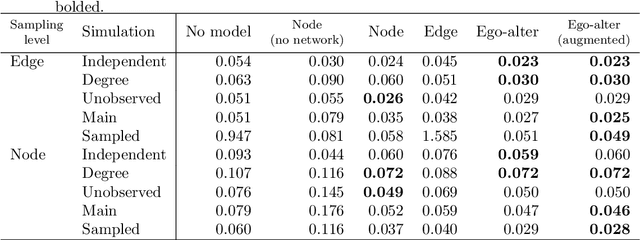
Abstract:In online social networks, it is common to use predictions of node categories to estimate measures of homophily and other relational properties. However, online social network data often lacks basic demographic information about the nodes. Researchers must rely on predicted node attributes to estimate measures of homophily, but little is known about the validity of these measures. We show that estimating homophily in a network can be viewed as a dyadic prediction problem, and that homophily estimates are unbiased when dyad-level residuals sum to zero in the network. Node-level prediction models, such as the use of names to classify ethnicity or gender, do not generally have this property and can introduce large biases into homophily estimates. Bias occurs due to error autocorrelation along dyads. Importantly, node-level classification performance is not a reliable indicator of estimation accuracy for homophily. We compare estimation strategies that make predictions at the node and dyad levels, evaluating performance in different settings. We propose a novel "ego-alter" modeling approach that outperforms standard node and dyad classification strategies. While this paper focuses on homophily, results generalize to other relational measures which aggregate predictions along the dyads in a network. We conclude with suggestions for research designs to study homophily in online networks. Code for this paper is available at https://github.com/georgeberry/autocorr.
How to make a pizza: Learning a compositional layer-based GAN model
Jun 06, 2019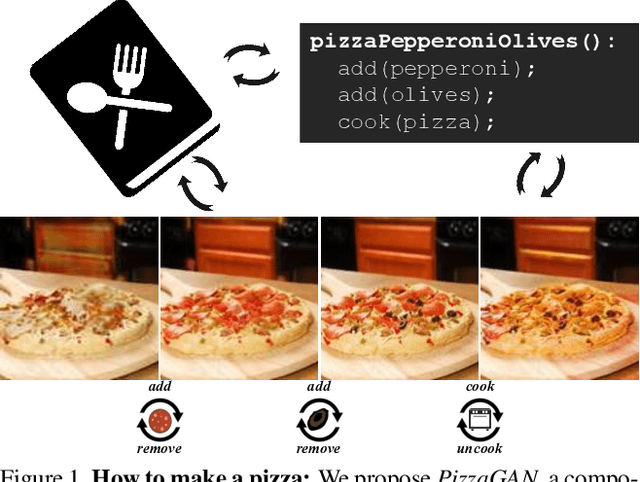
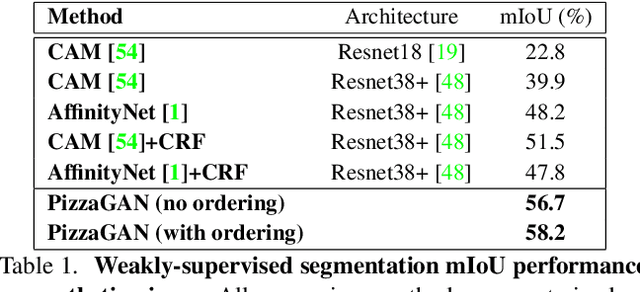


Abstract:A food recipe is an ordered set of instructions for preparing a particular dish. From a visual perspective, every instruction step can be seen as a way to change the visual appearance of the dish by adding extra objects (e.g., adding an ingredient) or changing the appearance of the existing ones (e.g., cooking the dish). In this paper, we aim to teach a machine how to make a pizza by building a generative model that mirrors this step-by-step procedure. To do so, we learn composable module operations which are able to either add or remove a particular ingredient. Each operator is designed as a Generative Adversarial Network (GAN). Given only weak image-level supervision, the operators are trained to generate a visual layer that needs to be added to or removed from the existing image. The proposed model is able to decompose an image into an ordered sequence of layers by applying sequentially in the right order the corresponding removing modules. Experimental results on synthetic and real pizza images demonstrate that our proposed model is able to: (1) segment pizza toppings in a weaklysupervised fashion, (2) remove them by revealing what is occluded underneath them (i.e., inpainting), and (3) infer the ordering of the toppings without any depth ordering supervision. Code, data, and models are available online.
Racial Bias in Hate Speech and Abusive Language Detection Datasets
May 29, 2019
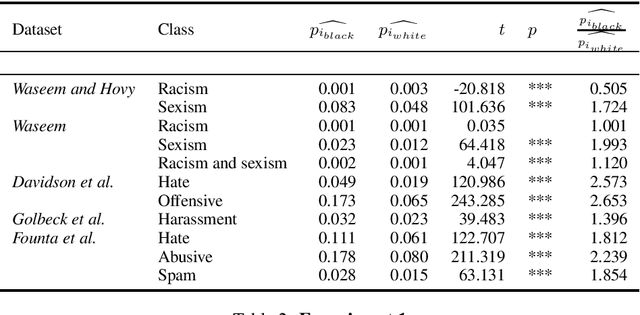
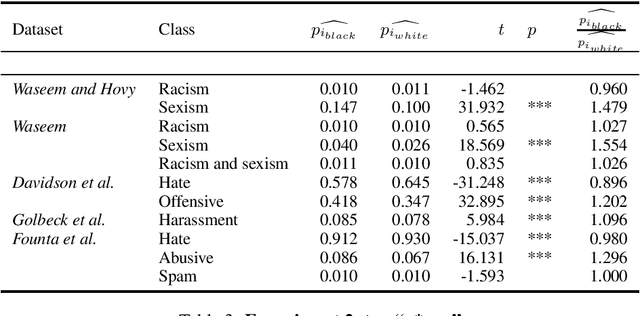
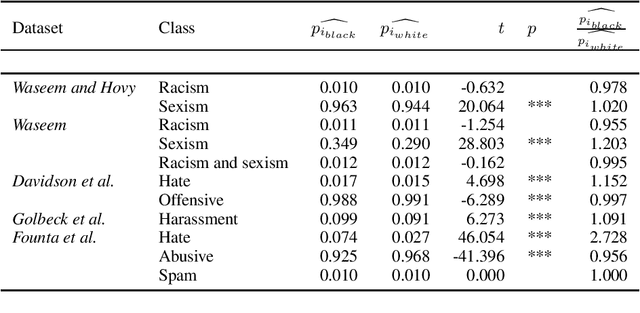
Abstract:Technologies for abusive language detection are being developed and applied with little consideration of their potential biases. We examine racial bias in five different sets of Twitter data annotated for hate speech and abusive language. We train classifiers on these datasets and compare the predictions of these classifiers on tweets written in African-American English with those written in Standard American English. The results show evidence of systematic racial bias in all datasets, as classifiers trained on them tend to predict that tweets written in African-American English are abusive at substantially higher rates. If these abusive language detection systems are used in the field they will therefore have a disproportionate negative impact on African-American social media users. Consequently, these systems may discriminate against the groups who are often the targets of the abuse we are trying to detect.
Recipe1M: A Dataset for Learning Cross-Modal Embeddings for Cooking Recipes and Food Images
Oct 14, 2018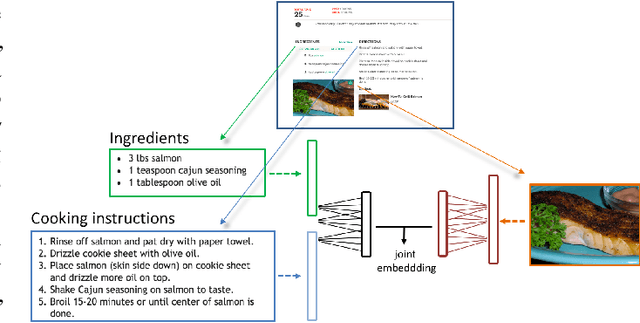

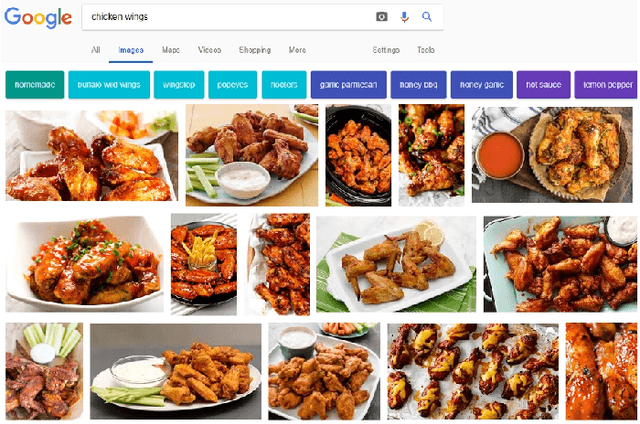

Abstract:In this paper, we introduce Recipe1M, a new large-scale, structured corpus of over one million cooking recipes and 13 million food images. As the largest publicly available collection of recipe data, Recipe1M affords the ability to train high-capacity models on aligned, multi-modal data. Using these data, we train a neural network to learn a joint embedding of recipes and images that yields impressive results on an image-recipe retrieval task. Moreover, we demonstrate that regularization via the addition of a high-level classification objective both improves retrieval performance to rival that of humans and enables semantic vector arithmetic. We postulate that these embeddings will provide a basis for further exploration of the Recipe1M dataset and food and cooking in general. Code, data and models are publicly available.
Understanding Abuse: A Typology of Abusive Language Detection Subtasks
May 30, 2017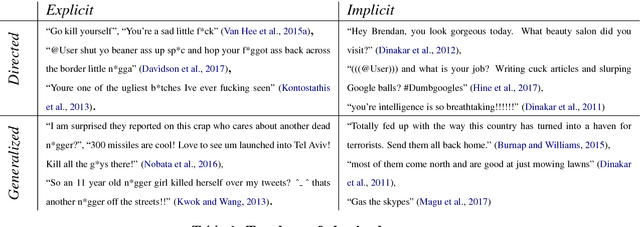
Abstract:As the body of research on abusive language detection and analysis grows, there is a need for critical consideration of the relationships between different subtasks that have been grouped under this label. Based on work on hate speech, cyberbullying, and online abuse we propose a typology that captures central similarities and differences between subtasks and we discuss its implications for data annotation and feature construction. We emphasize the practical actions that can be taken by researchers to best approach their abusive language detection subtask of interest.
 Add to Chrome
Add to Chrome Add to Firefox
Add to Firefox Add to Edge
Add to Edge